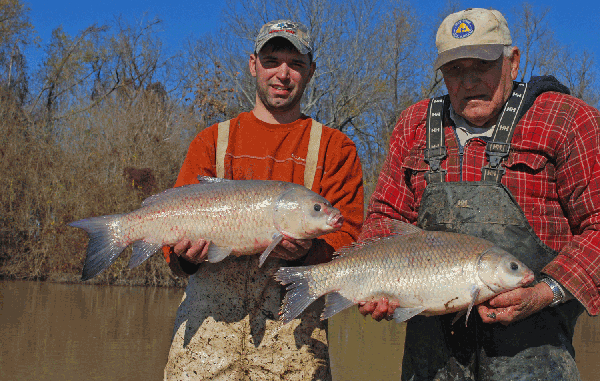
These suckers once were important food source
Actually, buffalo are three species of fish rather than one. No one knows from where the odd name for the creatures is derived. But their scientific names are almost certainly taken from their common name.
The first buffalo species was scientifically named in 1819 by Constantine Samuel Rafinesque-Schmalz, the eccentric French-born naturalist who had become a professor of botany at Transylvania University in Kentucky that same year. It was the smallmouth buffalo, Ictiobus bubalus. Both names are Greek in origin and mean “bull fish.” Land buffaloes or bison were often called bulls by the French.
The second species named was the black buffalo, Ictiobus niger, also named in 1819, again by Rafinesque. “Niger” is Latin for “black.” Last identified by scientists was the bigmouth buffalo, Ictiobus cyprinellus, in 1844. “Cyprinellus” is also Latin and means “little carp.”
Indeed, all three species are carp-like in appearance to the average sportsman, or at least to the average sportsman who has ever caught one.
In spite of growing to prodigious sizes (the IGFA records are 63 pounds for the black, 70 pounds for the bigmouth and 82 pounds for the smallmouth), they very seldom bite hooks and never take artificial lures.
In spite of their appearance, buffalo are not in the same family as carps, which are in the minnow family. Buffalos are in the sucker family, of which Louisiana has 11 other species that include three carpsuckers, three chubsuckers, two redhorses, a hogsucker, a blue sucker and a spotted sucker. Most of these are large enough to catch with a hook, but sportsmen seldom see them.
Buffalo were the most-important fishes, pound-wise, in Louisiana’s thriving freshwater commercial fishery of the 1920s to through the 1940s. This huge fishery was centered around a north-south axis from Morgan City in the south through Simmesport and Jonesville on the other end.
Catfish dominated the harvest in the south and buffalo were the mainstay fishery in the north, although both fish — along with gaspergou, gar, paddlefish, turtles and frogs — were taken everywhere.
Louisiana’s freshwater finfishery dwarfed its saltwater counterpart. In 1936, over 10 million pounds of buffalo, 4 1/2 million pounds of catfish and 1.7 million pounds of gaspergou were recorded. Compare this to the paltry saltwater harvest of 225,000 pounds of speckled trout, 85,000 pounds of flounder and 55,000 pounds of sheepshead for that same year.
Although any good ole Caucasian country boy knows what to do with a buffalo, they have always been considered an “ethnic fish.” Back in the day, smallmouth buffalo were the most-desirable of the three buffalo species. The best of the catch, sold as “No 1. white buffalo,” were marketed in the northern United States and were principally consumed in the Jewish trade.
Lesser-quality white buffalo, as well as bigmouth buffalo (called common buffalo) and black buffalo (mongrel buffalo), were sold as No. 2 grade in an area primarily from Texas in the west through Oklahoma, Missouri and Kentucky. African-Americans were the largest consumer.
Although the fishery is now much smaller, the market has remained ethnic. Scientists at the Southern Regional Aquaculture Center looked at buffalo a dozen years ago as a possible species to stock in catfish ponds with catfish to add to fish farmers’ income. In theory, the buffalo would not compete with catfish because they would feed on plankton and small bottom life, but would produce more income for the farmer than would catfish harvests alone.
Their market study revealed that the strongest markets were in northern and western urban areas. Eighty-three percent of the harvest was sold to African-Americans, and 6 percent went to Asians or Central Europeans.
Buffalo of all three species have a mild, white flesh that the initiated agree is better than catfish or many species of freshwater game fish. The problem is bones: Their flesh contains many, many tiny bones, unattached to the backbone and “floating” freely in the muscle.
Only the flesh on their meaty ribs is free of bones, so naturally enough buffalo ribs are the highest-priced part of the fish. After the rib slab is removed from the fish, it is sliced vertically between the large rib bones and fried.
All three species of buffalos are found in Louisiana, being most common in large rivers, as well as lakes. They are easy to tell apart. Smallmouth buffalo are nowadays often descriptively called “razorbacks,” with good reason. Viewed head-on, they have a high-arching, narrow back. Also very noticeable is what is called a “subterminal mouth,” meaning that it isn’t located at the tip of the snout, but rather beneath it.
The downward-pointing mouth allows the animal to efficiently feed on bottom organisms such as tiny crustaceans, snails, clams, insect larvae, algae and the remains of dead plants and animals. Smallmouth buffalo will occasionally take a hook baited with dead bait or, best of all, a doughball or corn. The color of smallmouth buffalos will vary, but most have a distinct green tinge on the upper sides and back.
Bigmouth buffalo also carry a descriptive nickname — “gourdhead.” The name comes from the rounded, blocky head that carries over into their body shape. They definitely lack the arched, narrow body profile of the smallmouth buffalo. Another major difference is that their mouths are located terminally — on the end of their snout.
Unlike their bottom-feeding cousin, bigmouth buffalo are filter feeders, using forward pointing extensions from their gill arches to strain free-swimming microscopic animals (zooplankton) from the water while swimming in mid-water depths. Because of their diet and manner of feeding, they are caught on hooks less often than are smallmouth buffalo. Their body color is less greenish than the smallmouth buffalo and more a brownish-olive coppery hue.
Easily the least-common buffalo is the black buffalo, usually called the “blue rooter” — probably because it has the darkest of the body colors of any buffalo, especially during spawning season, when it becomes a slatey-blue olive color. Its body shape is somewhat in between that of the other two buffalos, giving rise to the old nickname, “mongrel buffalo.” Because of their appearance, some fishermen once believed they were an uncommon hybrid between the smallmouth and bigmouth species.
While their body shape is very much in between the other two species, their mouths are located more similarly to the smallmouth buffalo’s, and they are bottom feeders, as well, seeming to prefer a diet of small clams.
While any species of buffalo can be caught anywhere within their range in freshwater, the black buffalo seems to much prefer the habitat of fairly swift-flowing rivers, even more so than the smallmouth buffalo.
Buffalo spawn between March and June when water temperatures are from 66 to 75 degrees. Spawning usually takes place in flooded backwater areas and sloughs, and is a noisy affair, with much splashing and commotion. Spawning is done in large groups, called “buffalo spawns,” with males seeming to push ripe females to the surface to prod them into releasing their eggs.
During spawning, the fish seem to lose all their sense of caution and can easily be netted, arrowed or speared.
Their fertilized eggs sink to the bottom and become sticky, adhering to water plants, gravel or any other hard surface until they hatch.
Adults provide no care for the young.




